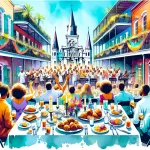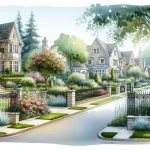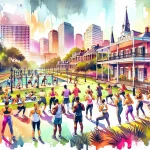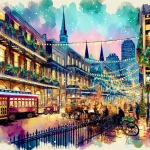Along the Mississippi River in Louisiana, a captivating tradition illuminates the night sky each Christmas Eve. The Christmas Eve Bonfires on the Levee, a beloved custom in New Orleans and the surrounding River Parishes, draw thousands of spectators annually to witness the awe-inspiring display of towering wooden structures set ablaze in a brilliant celebration of community spirit and holiday joy.
In This Article
TL;DR
- The Christmas Eve Bonfires on the Levee have deep historical roots in Louisiana, representing community unity and cultural heritage.
- Families and friends gather to construct elaborate bonfire structures along the Mississippi River levees, showcasing architectural artistry and craftsmanship.
- The event fosters community bonding, attracts visitors, and celebrates the unique traditions of New Orleans and the River Parishes.
Historical Roots of the Tradition
The precise origins of the Christmas Eve Bonfires on the Levee remain somewhat unclear, but it is believed that the tradition may have been introduced by French Marist priests who arrived in Louisiana after the Civil War. These priests, who came to teach at local cottages, likely adapted the custom from ancient midwinter festivals celebrated throughout Western Europe.
Over time, the tradition evolved from simple fires to the elaborate constructions seen today. Oral histories dating back to the 1880s mention the bonfires, and the practice has been passed down through generations, becoming an integral part of the local culture and identity.
Significance and Symbolism
The Christmas Eve Bonfires on the Levee hold deep symbolic meaning for the communities along the Mississippi River. According to local folklore, the fires serve to light the way for Papa Noël, the Cajun Santa Claus, as he navigates the river on his journey to deliver presents to the children of the region.
Beyond the connection to Papa Noël, the bonfires also represent a powerful symbol of community unity and cultural heritage. The act of coming together to build and light the structures strengthens social bonds and reinforces a sense of shared identity among participants and spectators alike.
Architectural Artistry of the Bonfires
The construction of the Christmas Eve Bonfires is a testament to the skill and creativity of the builders. While the most traditional form is a simple pyramid shape, the structures have evolved over the years to include more elaborate designs. Some bonfires are crafted to resemble miniature plantation homes, tiny replica paddlewheel steamships, or even local landmarks.
Builders typically use fast-growing, dry woods like willow, avoiding hardwoods that are more difficult to burn. Cane reed is often added to the structures to create a festive pop and sparkle during the burning process. Safety is a top priority, with regulations in place governing the size and placement of the bonfires, and local fire departments supervising the events.
Preparations and Community Involvement
The planning and preparation for the Christmas Eve Bonfires begin well in advance of the event. Families, friends, and co-workers gather to construct their bonfires, often spending days or even weeks working on their creations. The atmosphere during the build is reminiscent of a festive tailgate party, with participants cooking, mingling, and celebrating together.
The bonfire tradition has a significant impact on the local economy, with businesses experiencing a surge in activity during the weeks leading up to Christmas Eve. The event also draws visitors from around the world, providing a boost to the hospitality industry in New Orleans and the surrounding areas.
The Night of the Event
On Christmas Eve, the levees along the Mississippi River come alive with the glow of countless bonfires. Spectators gather to watch as the structures are doused with flammable liquids and set ablaze, illuminating the night sky with towering flames and sparks. The fires are often accompanied by fireworks displays, adding to the festive atmosphere.
Attendees share stories, laughter, and the warmth of community as they bask in the light of the bonfires. In some locations, local residents even serve up free bowls of hot gumbo to the gathered crowds. The experience is one of joy, togetherness, and a deep appreciation for the unique cultural heritage of the region.
Cultural Impact and Modern Relevance
The Christmas Eve Bonfires on the Levee are a powerful reflection of the cultural dynamics of New Orleans and the River Parishes. The tradition serves as a unifying force, bringing together people from diverse backgrounds to celebrate a shared history and identity.
In an increasingly globalized and fast-paced world, the bonfires offer a rare opportunity for communities to slow down, come together, and connect with their roots. The tradition has faced challenges and adaptations over the years, such as changes in land use along the levees and evolving safety regulations, but the spirit of the event remains strong.
Comparison to Other Winter Traditions
The Christmas Eve Bonfires on the Levee share similarities with other winter solstice and Christmas Eve traditions around the world, such as the Yule log in Europe and the luminarias of the American Southwest. However, the scale, community involvement, and unique designs of the Louisiana bonfires set them apart as a one-of-a-kind cultural phenomenon.
Expert Insights and Future Outlook
Cultural historians, local leaders, and event organizers agree that the Christmas Eve Bonfires on the Levee are a vital part of Louisiana’s cultural heritage and identity. Efforts are ongoing to ensure the sustainability and future of the tradition, with a focus on safety, environmental stewardship, and community engagement.
As the tradition continues to evolve, innovations and adaptations may shape its future. However, the core values of community, celebration, and connection to the past are likely to remain at the heart of the Christmas Eve Bonfires on the Levee for generations to come.
Visitor Information:
- Best Viewing Locations: St. James Parish, particularly in and around Gramercy, Lutcher, and Paulina.
- Parking: Special parking lots are set up within walking distance of the bonfires, but early arrival is recommended due to heavy traffic.
- Guided Tours: Gray Line Tours offers a four-hour Christmas Eve Bonfire Express, which includes round-trip transportation and narration. Reservations required. Call (504) 569-1401 or (800) 233-2628 for details.
- Festival of the Bonfires: Held annually in Lutcher, featuring a gumbo cook-off, live music, and the lighting of the bonfires.
- Algiers Bonfire & Concert: A smaller-scale celebration held in Algiers Point, just across the Mississippi River from the French Quarter.






